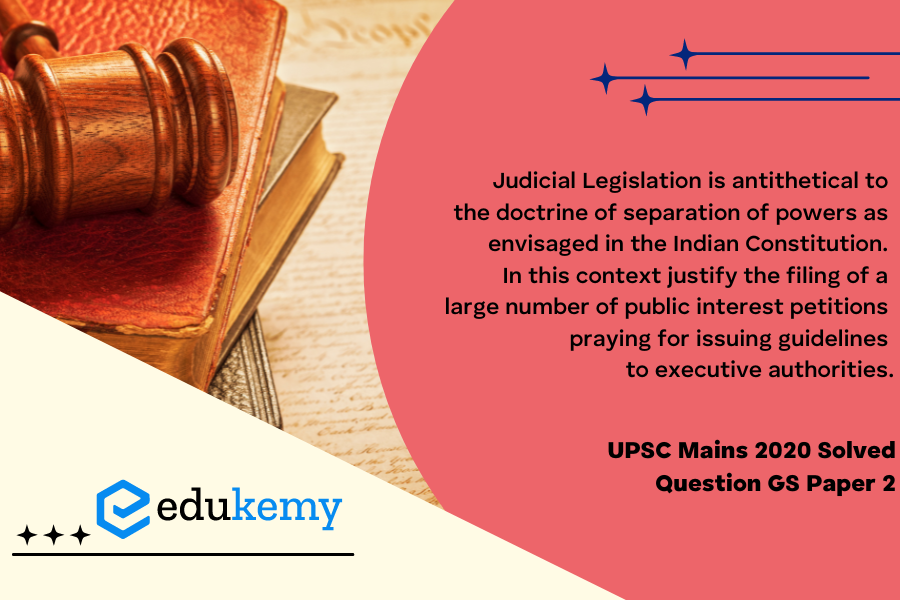
While Judicial Legislation may seemingly challenge separation of powers, public interest petitions seeking guidelines aim to ensure accountability and protect citizens’ rights. Courts, acting as checks on executive powers, address gaps in legislation, promoting a fair and just society within constitutional bounds, justifying such interventions in the interest of public welfare.
UPSC Mains General Studies Paper – 2 Mains 2020
UPSC Mains Civil Services IAS Exam Question Paper – 2020
Tags: Separation of powers between various organs, dispute redressal mechanisms and institutions.
Contents
Approach
- In the Introduction, try to mention the Doctrine of Separation of Powers.
- In Body,
- Judicial Legislation and instances of its implementation.
- Judiciary and Public Interest Litigation (PIL).
- In Conclusion, try to suggest a healthy implementation of Judicial Legislation.
Answer
The tenet of separation of powers conceives explicit powers given to the legislature, executive and the judiciary. It infers negligible obstruction by one organ in the working of another organ. This doctrine is one of the basic structures of the constitution. Various constitutional provisions like Article 50, 121, and 211, etc. embody the spirit of this doctrine.
- The executive is vested with the power to make policy decisions and implement laws.
- The legislature is empowered to issue enactments and review the functioning of the executive.
- The judiciary is responsible for adjudicating disputes. The judiciary also exercises judicial review over the executive and legislative action (Article 32 and 226).
The separation of powers is important because it provides a vital system of ‘checks and balances’.
Judicial Legislation and Instances of Implementation
- Making law is the domain of the legislature. But occasionally, the judiciary has issued guidelines and made policies in the cloak of judgments, assuming the power of the legislature.
- For example, in Arun Gopal case (2017), the Supreme Court fixed timings for bursting Diwali fireworks, although there are no laws to that effect.
- In M.C. Mehta case (2018), the court annulled the Rule 115(21) of the Central Motor Vehicle Rules, 1989, when it directed that only BS-VI vehicles can be sold after March 30, 2020.
Judiciary and Public Interest Litigation (PIL)
- Need for Public Interest Litigation(PIL):
- Social Justice meets Social Ends: Public interest petitions are instrumental in bringing about a new code of something when there is no legislative framework for it, nor it is possible to have it in the near future.
- Non-performance of Duty: Often the legislature fails to make the necessary legislation to suit the changing times and the executive fails to perform their administrative functions.
- Help to Marginalised Section: PILs falling under the categories such as bonded labour matters, neglected children, non-payment of minimum wages to workers and exploitation of casual workers, and petitions from jails complaining of harassment, against atrocities on women etc. It can help advance the cause of minority or disadvantaged groups or individuals.
- Justice is Directly Accessible: In the Asiad Workers judgment case, Justice P.N. Bhagwati held that anyone getting less than the minimum wage can directly approach the Supreme Court without going through the labor commissioner and lower courts.
- Judicial Intervention: The judiciary has been compelled to intervene in the domain of legislature and issued guidelines to the executives in the cases of fundamental rights of the people being threatened by the State, failure in performing administrative functions by authorities and failure of legislature to make the necessary legislation in the changing times:
- In K.Puttaswamy case(2017), the court pronounced that the right to privacy is intrinsic to the right to life and provided the three step test to decide on the constitutionality of any law infringing privacy.
- In Vishaka case(1997), the judgement recognised sexual harassment as a violation of the fundamental rights and the guidelines also directed for the Sexual Harassment of Women at Workplace (Prevention, Prohibition and Redressal) Act, 2013.
Conclusion
Thus, though Judicial Legislation is antithetical to the doctrine of separation of powers, sometimes it becomes justifiable for the judiciary to issue guidelines to executive authorities. Nevertheless, with a view to see that judicial activism does not become judicial adventurism, the courts must act with caution and proper restraint. In the spirit of democratic governance, all the three organs of the State should discharge their obligations freely and independently, entrusted with intervention only where required in the larger interest of the citizens of India.
In case you still have your doubts, contact us on 9811333901.
For UPSC Prelims Resources, Click here
For Daily Updates and Study Material:
Join our Telegram Channel – Edukemy for IAS
- 1. Learn through Videos – here
- 2. Be Exam Ready by Practicing Daily MCQs – here
- 3. Daily Newsletter – Get all your Current Affairs Covered – here
- 4. Mains Answer Writing Practice – here

